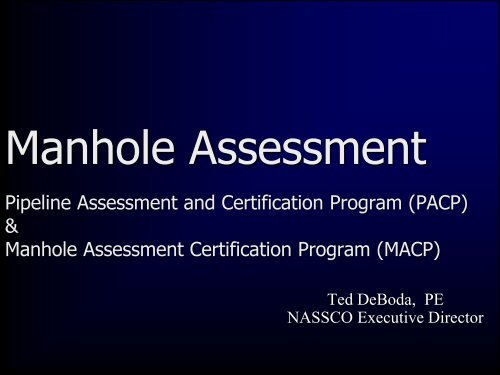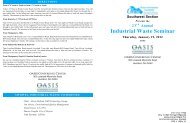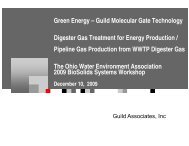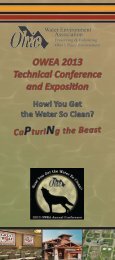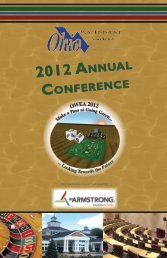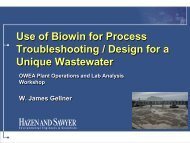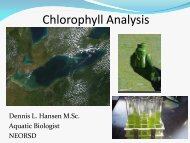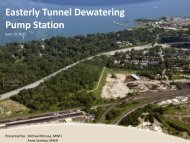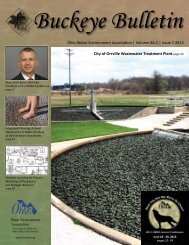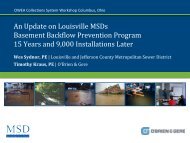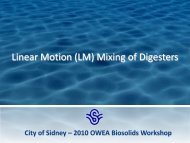PDF File - Ohio Water Environment Association
PDF File - Ohio Water Environment Association
PDF File - Ohio Water Environment Association
Create successful ePaper yourself
Turn your PDF publications into a flip-book with our unique Google optimized e-Paper software.
Manhole Assessment<br />
Pipeline Assessment and Certification Program (PACP)<br />
&<br />
Manhole Assessment Certification Program (MACP)<br />
Ted DeBoda, PE<br />
NASSCO Executive Director
Outline<br />
• NASSCO<br />
• Defects and Observations<br />
• Inspection and Defect Coding<br />
• Deliverables<br />
• Rehabilitation
Introduction to NASSCO<br />
Background<br />
• The National <strong>Association</strong> of Sewer<br />
Service Companies (NASSCO) is a<br />
not-for-profit corporation serving all<br />
areas of the pipeline assessment<br />
and rehabilitation industry since<br />
1976<br />
4
Introduction to NASSCO<br />
Mission<br />
NASSCO, the National <strong>Association</strong> of<br />
Sewer Service Companies, is<br />
committed to setting industry<br />
standards for the assessment and<br />
rehabilitation of underground<br />
pipelines, and to assure the continued<br />
acceptance and growth of trenchless<br />
technologies.<br />
6
Introduction to NASSCO<br />
Membership<br />
• Membership Categories<br />
– Contractor<br />
– Associate (Manufacturers/Suppliers)<br />
– Professional (Engineers/Consultants)<br />
– Public Agencies<br />
• Membership continues to grow (doubled in the last 5<br />
years)<br />
• Nearly 400 member organizations<br />
7
Background of Industry<br />
Standardization<br />
• Industry in US had no standards<br />
• NASSCO led effort to develop<br />
• Based on <strong>Water</strong> Research Centre codes<br />
– Many years of use in UK<br />
– WRc providing consulting services to NASSCO<br />
• Standardization includes multiple software options,<br />
multiple contractors, industry acceptance,<br />
standardized training, and technical support<br />
– Standardization concept more important than the<br />
benefits of one code system compared to another<br />
8
Delaware DOT Pipe Inspection Manual
Learning<br />
Standardized
Crack and Fracture<br />
Crack = not open<br />
Fracture = visibly open
CCTV camera is tilted<br />
120.3 JO M<br />
120.3 FS J 03 08
108.6 RBJ 55 J 08 04
111.3 B J 09 03
9.2 OBR S01 20<br />
04 08
30.4 RFB 11<br />
30.4 FL J 11
Manhole Component<br />
Observations Form<br />
Manhole Component<br />
Observations Form<br />
Manhole<br />
Component<br />
Observations<br />
Form<br />
Manhole<br />
Component<br />
Defect<br />
Form
Manhole<br />
Component<br />
Observations<br />
Form<br />
Manhole<br />
Component<br />
Defect<br />
Form
Manhole<br />
Component<br />
Observations<br />
Form<br />
Manhole<br />
Component<br />
Defect<br />
Form<br />
Manhole<br />
Component<br />
Observations<br />
Form
Corroded
10.6
Missing<br />
Note:<br />
When the frame is<br />
missing, other fields<br />
related to the frame<br />
are optional
Fractured
0.4 CMI MB 12 12<br />
0.4 CMI MML L 12 12<br />
1
8.4 WI RFB 12 12
0.5 CMI IR 10 03<br />
1.2 COI IR S 10 03<br />
1.9 WI IR S01<br />
S 10 03
10.4 WI SRC 12 12<br />
2
9.4 WI MB 05 07<br />
9.4 WI RFB 05 07
6.2 WI RBB J 05 11<br />
6.3 B RBB J 05 11
0.4 CMI MB 12 12<br />
0.4 CMI MML L 12 12<br />
1
10.4 WI SRC 12 12<br />
2
1<br />
.<br />
.<br />
.<br />
.
111.3 B J 09 03<br />
2
2<br />
.<br />
.<br />
.<br />
.
http://maps.dublin.oh.us/dubscovery/
Manhole Rehab<br />
Recommendations<br />
1<br />
Frame and Cover Replacement<br />
Frame Adjustment<br />
Mechanical Seal<br />
Liner<br />
or<br />
or
Manhole Rehab<br />
Recommendations<br />
2<br />
Cured-in-Place Liner<br />
Replacement<br />
Reference PACP Manhole Specification<br />
Guidelines<br />
or
More Information<br />
Ted DeBoda, P.E.<br />
NASSCO<br />
Executive Director<br />
director@nassco.org<br />
(410) 486-3500
RECENT CHANGES TO<br />
NASSCO PACP<br />
4.4.3 to 6.0.1
Overview of PACP Coding Changes<br />
• Hinge Defects (Ver. 4.43)<br />
– CH2, CH3, CH4<br />
– FH2, FH3, FH4<br />
• Lining Features (Ver. 4.43)<br />
– LFAS – Annular Space<br />
– LFBU – Bulges<br />
– LFDC – Discoloration<br />
– LFDL – Delamination<br />
– LFRS – Resin Slug<br />
– LFPH – Pinholes<br />
• Buckling Code (K) (Ver. 6.0)<br />
– KW – Buckling Wall<br />
– KD – Buckling Dimpling<br />
– KI – Buckling Inverse Curvature
Hinge Defects<br />
• When more than one longitudinal crack (CL)<br />
and/or fracture (FL) occur at the same footage<br />
• These defects should be parallel and not intersect<br />
• These defects are seen at 12, 06 & 03, 09 o’clock<br />
positions
Lining Features (LF)<br />
• LFAS – Annular Space<br />
– The liner does not closely fit against the host pipe<br />
– A gap between the liner and the host pipe is visible<br />
• LFBU – Bulges<br />
– The host pipe contains intruding defects (broken pipe,<br />
taps) that bulge the liner<br />
• LFDC – Discoloration<br />
– Liner with abnormal coloration
Buckling (K)<br />
• Refer to deformations and other defects without<br />
loss of visible structural integrity in flexible pipes<br />
• Plastic, pitch fiber pipes, metal, etc.<br />
• Flexible pipes are expected to deflect to allow<br />
pipe interaction with soil. However, excessive<br />
deflection and other surface damages are signs of<br />
structural distress
Buckling Wall (KW)<br />
Distance<br />
(feet)<br />
Video<br />
Ref<br />
Group /<br />
Descrip<br />
Code<br />
Modifier /<br />
severity<br />
Continuous<br />
defect<br />
S/M/<br />
L<br />
Value<br />
Circumferential<br />
Joint location<br />
Inches % At / To<br />
1st 2nd<br />
from<br />
25.8 KW 08 03
Buckling – Dimpling (KD)<br />
Distance<br />
(feet)<br />
Video<br />
Ref<br />
Group /<br />
Descrip<br />
Code<br />
Modifier /<br />
severity<br />
Continuous<br />
defect<br />
S/M/<br />
L<br />
Value<br />
Circumferential<br />
Joint location<br />
Inches % At / To<br />
1st 2nd<br />
from<br />
7.5 KD 04
Buckling – Inverse Curvature (KI)<br />
Distance<br />
(feet)<br />
Video<br />
Ref<br />
Group /<br />
Descrip<br />
Code<br />
Modifier /<br />
severity<br />
Continuous<br />
defect<br />
S/M/<br />
L<br />
Value<br />
Circumferential<br />
Joint location<br />
Inches % At / To<br />
1st 2nd<br />
from<br />
1.2 KI 10 12
Other PACP Changes<br />
• Measurements of defects less than 3 feet (1 m)<br />
may be added to the value-inches column<br />
• Digital measurements allowed to 3 decimal points<br />
• Deformed Vertical and Horizontal can refer to<br />
other than brick sewers.
PACP Version 6.0 Training<br />
Changes<br />
• Syllabus change – 2 full days<br />
• Additional video and training material
MACP® Version 6.0 Content Changes<br />
• Two Levels of Inspection<br />
– Level 1<br />
• Basic condition assessment information<br />
• Determines if Level 2 inspection<br />
necessary<br />
– Level 2<br />
• Fully document defects<br />
• Specific Information to recommend<br />
corrective actions
MACP® Version 6.0 Content Changes
MACP® Version 6.0 Content Changes<br />
• Additional Training Materials<br />
– More component details<br />
– Specific measurement graphics
MACP® Version 6.0 Content Changes<br />
• Manhole Component Defect Form (for<br />
Level 2 Inspections)<br />
– Similar to PACP® CCTV Inspection Form<br />
– Includes two additional columns<br />
• Component<br />
• Step
MACP® Version 6.0 Training Changes<br />
• PACP is STILL a Prerequisite<br />
• New Syllabus – 4.5 to 5 hours
LACP® Version 6.0<br />
• New in PACP® 4.3<br />
• Very similar to PACP®<br />
• Emphasis on<br />
– Types of Lateral Inspections and Lateral<br />
configurations<br />
– New Fittings and Access Codes
PACP®, MACP®, and LACP®<br />
Upcoming Changes<br />
• User Recertification<br />
– 3 year certifications<br />
– Recertification Training being<br />
developed<br />
• Trainer Recertification<br />
– No automatic recertification<br />
– New Application Process<br />
– New Training Syllabus
More Information<br />
Ted DeBoda, P.E.<br />
NASSCO<br />
Executive Director<br />
director@nassco.org<br />
(410) 486-3500


